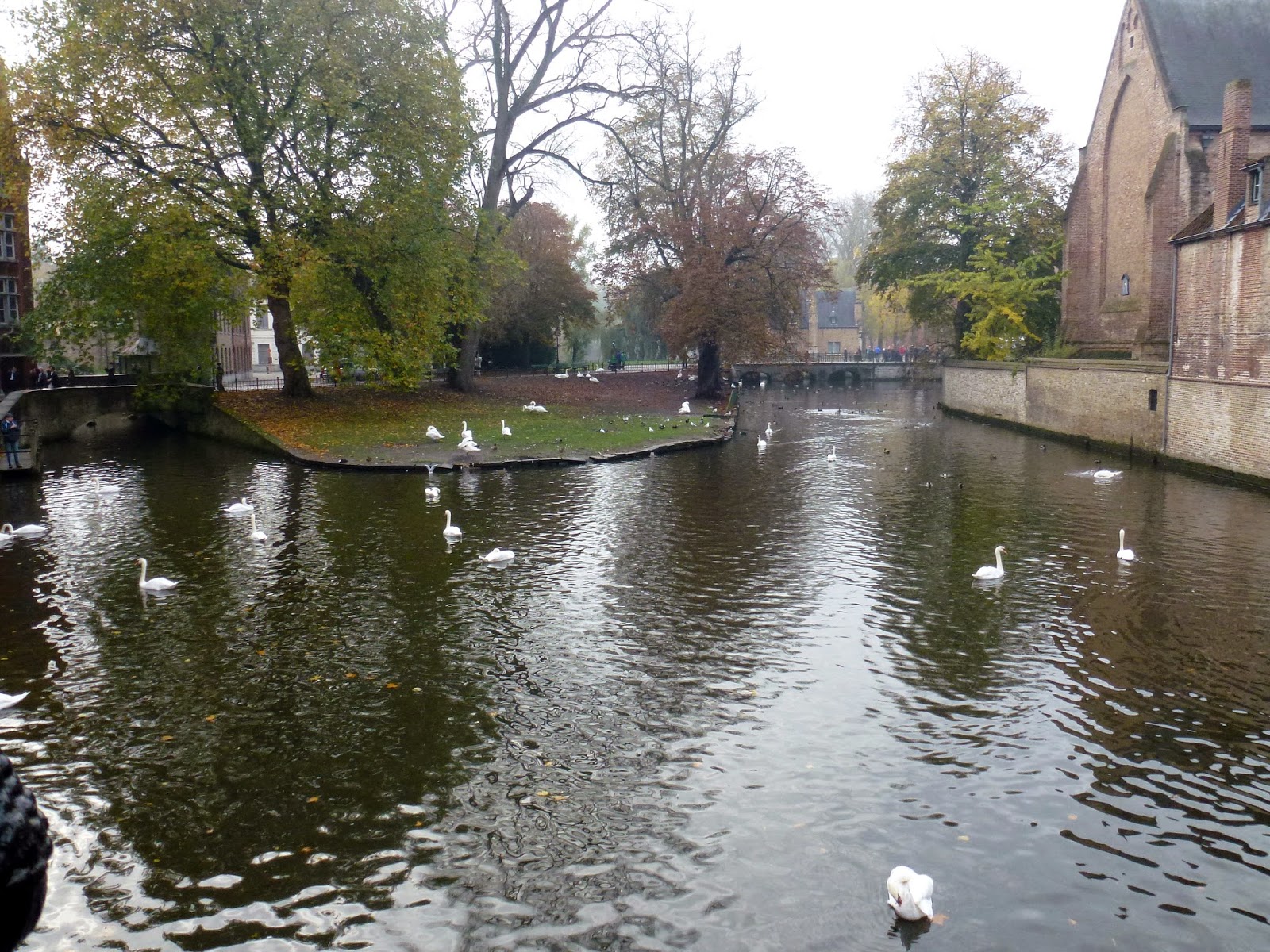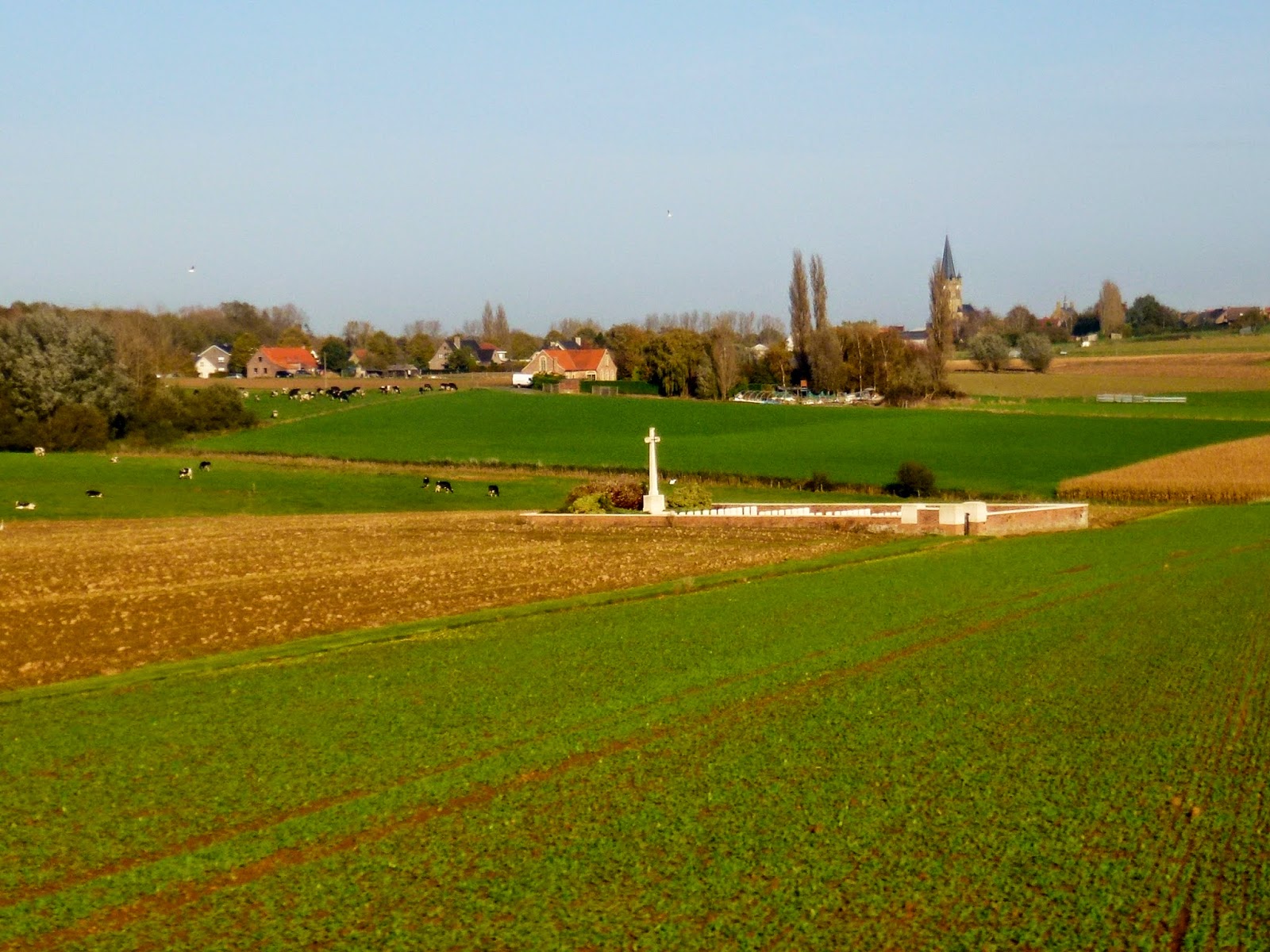So! We stopped where everyone else does and took a pic of the Belfry. I climbed it when I was eleven or twelve and we were on a family holiday so I didn't join the long queue to climb it again. 366 steps! This time we had arrived in the evening and it was raining. We walked in the rain and visited the bar under the awning for a drink while we looked up the canal at the famous view of the Belfry.
It is a beautiful city and we were thrilled to be able to walk around and see everything with such ease. The next day the sun came out and the city started to fill up. Apparently day-trippers regularly cross the channel and spill into Brugge for a few hours. All of a sudden it seemed like we were sharing the city with the rest of the world.
We retreated into quieter places. We had already "done" the chocolatier and bought some very expensive chocolate.
and so after a guided walking tour of the main sites we settled down to a Moules Frites lunch at a cafe near the swans and the convent of the begging nuns. We battled the crowds for a while, listened to some drummers in the square and had a coffee.
In the evening we returned to catch the towers lit up. Many of the day-trippers had gone home but the main square was still full of folks. The Belfry does tilt by about a metre at the top but in the opposite direction to how it looks here!
On the last morning we went on a canal boat. It was early and there were only a few of us on it so the low bridges loomed even lower as our boat rode higher in the water. Everyone else ducked for this bridge but I was busy lining up the pic and only just missed knocking myself out when I looked up. There were a few gasps from the others as the bridge slid past.
On Friday 31st october, Jeremy Banning accompanied us around the battlefields, cemeteries and tunnelling sites of Ypres Salient. He is an expert on the Tunnellers, the geology and geomorphology and an engineer. He has worked and is working on documentaries, TV shows and books. He was our guide.
This was an area held by the British and their allies against the Germans and their allies, during WW1.
The battles were continuous for four years in this area and the more determined and named assaults were instrumental in gaining and losing advantages and territory. Passchendaele is such a name and an amazing Museum has been built to give an experience of the trenches and dug-outs to visitors.
Many, many thousands were killed. Some are buried with acknowledgement of who they are. Others are buried. Most are not buried. Their remains too shattered or never found. Memorials to them stand high and all their names are inscribed somewhere.
Some cemeteries like this one at Tyne Cot are very large and others just take up a small part of a farmer's field, but every one is beautifully looked after.
Tunnelling deep under the ground was one of the battle tactics of this and other areas. Massive mines were blown up from deep under the enemies' lines by both sides. Giant craters remain where hundreds and even thousands of men were obliterated in seconds.
Much of the area has been returned to agriculture...sheep and cattle graze, brussel's sprouts and potatoes are grown...
...but there are still some places like Hill 60, where the remains of war are untouched and the grass and trees grow silently there.
At sunset, the "Last Post" is sounded at 20.00 at The Menin Gate on the outskirts of Ypres City. We were there.
As were thousands of others...
...Every day, every week, every year, in all weathers.
Lest We Forget
Cheers Gillian
It is a beautiful city and we were thrilled to be able to walk around and see everything with such ease. The next day the sun came out and the city started to fill up. Apparently day-trippers regularly cross the channel and spill into Brugge for a few hours. All of a sudden it seemed like we were sharing the city with the rest of the world.
We retreated into quieter places. We had already "done" the chocolatier and bought some very expensive chocolate.
and so after a guided walking tour of the main sites we settled down to a Moules Frites lunch at a cafe near the swans and the convent of the begging nuns. We battled the crowds for a while, listened to some drummers in the square and had a coffee.
In the evening we returned to catch the towers lit up. Many of the day-trippers had gone home but the main square was still full of folks. The Belfry does tilt by about a metre at the top but in the opposite direction to how it looks here!
On the last morning we went on a canal boat. It was early and there were only a few of us on it so the low bridges loomed even lower as our boat rode higher in the water. Everyone else ducked for this bridge but I was busy lining up the pic and only just missed knocking myself out when I looked up. There were a few gasps from the others as the bridge slid past.
On Friday 31st october, Jeremy Banning accompanied us around the battlefields, cemeteries and tunnelling sites of Ypres Salient. He is an expert on the Tunnellers, the geology and geomorphology and an engineer. He has worked and is working on documentaries, TV shows and books. He was our guide.
This was an area held by the British and their allies against the Germans and their allies, during WW1.
The battles were continuous for four years in this area and the more determined and named assaults were instrumental in gaining and losing advantages and territory. Passchendaele is such a name and an amazing Museum has been built to give an experience of the trenches and dug-outs to visitors.
Many, many thousands were killed. Some are buried with acknowledgement of who they are. Others are buried. Most are not buried. Their remains too shattered or never found. Memorials to them stand high and all their names are inscribed somewhere.
Some cemeteries like this one at Tyne Cot are very large and others just take up a small part of a farmer's field, but every one is beautifully looked after.
Tunnelling deep under the ground was one of the battle tactics of this and other areas. Massive mines were blown up from deep under the enemies' lines by both sides. Giant craters remain where hundreds and even thousands of men were obliterated in seconds.
Much of the area has been returned to agriculture...sheep and cattle graze, brussel's sprouts and potatoes are grown...
...but there are still some places like Hill 60, where the remains of war are untouched and the grass and trees grow silently there.
At sunset, the "Last Post" is sounded at 20.00 at The Menin Gate on the outskirts of Ypres City. We were there.
As were thousands of others...
...Every day, every week, every year, in all weathers.
Lest We Forget
Cheers Gillian














